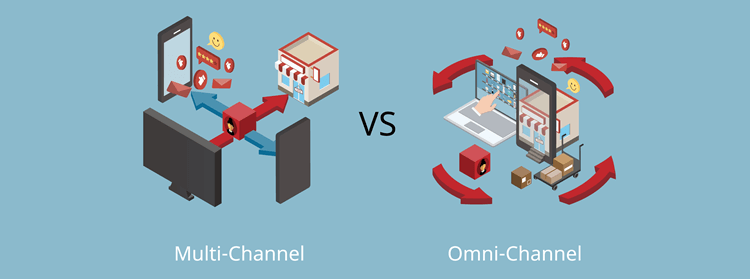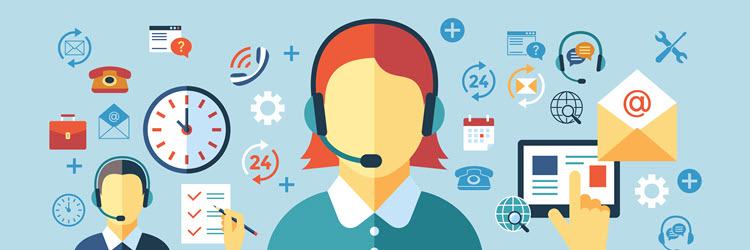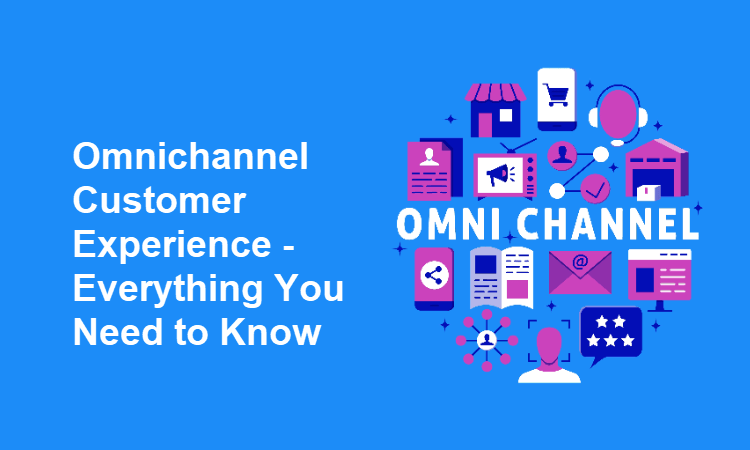The omnichannel approach arose because of businesses’ efforts to integrate the ever-growing number of channels and touchpoints available to their customers. Customers started demanding and expecting smooth experiences, forcing businesses to develop innovative ways to meet these desires.
The essence of omnichannel is customer satisfaction. But how does a business provide the best possible customer experience in an omnichannel environment?
This article defines what an omnichannel customer experience is, explains how it works, and analyzes successful real-life examples.
What Is Omnichannel Customer Experience?
An omnichannel customer experience (shortened omnichannel CX) consists of frictionless transitions between omnichannel customer journey touchpoints, helping customers achieve their goals quickly and easily.
The core idea of omnichannel experiences is to give customers control over the way they engage with your brand and provide them with easy access to all the tools necessary to navigate the omnichannel environment.
Omnichannel Customer Experience vs. Multichannel Customer Experience

The best way to understand the impact of an omnichannel customer experience is to understand how it works and how it compares to a multichannel customer experience.
How Does an Omnichannel Customer Experience Work?
An omnichannel customer experience connects all marketing and sales channels to each other and to the customer management system. That way, all channels have real-time access to the data the customer provides as they traverse the customer journey. Customers can easily shift between digital or in-person channels or different digital devices and maintain the progress they made in the customer journey.
Channel connections require thoughtful design, meticulous development, and regular maintenance. This can prove challenging because all channels must work as a whole. If one touchpoint breaks, some customers will be stuck in the journey and most likely give up on completing it.
An omnichannel customer experience benefits all parties involved even after the customer has achieved their goal. Every interaction a customer makes with a business is used to personalize future interactions. The result is that the right content, products, and services find their way to the right customer every time.
To successfully implement and provide an omnichannel customer experience, a business must adopt a customer-centric approach and invest in channel integration.
How Does a Multichannel Customer Experience Work?
A multichannel customer experience involves using a single channel to start and complete the customer journey. This means that if a customer starts their journey using one channel and wants to shift to another, they will have to start their journey all over again.
The focus of multichannel lies in the individual channels, all of which are designed and developed separately. In case of channel outage, the customer is forced to switch to another channel, perhaps one they dislike or do not know how to navigate through.
A channel-centric marketing approach results in lower channel maintenance costs but harms the customer experience. According to SDL, 90% of customers expect consistent interactions across all channels. As a result, businesses that fail to provide an omnichannel experience have a challenging time attracting new and engaging existing customers.
Why is Omnichannel Customer Experience Important?
The importance of the omnichannel customer experience lies in the benefits it provides to both businesses and consumers. These benefits include:
- Increased customer retention. Positive customer experiences increase customer loyalty and encourage them to make more frequent and higher-value purchases.
- Marketing to a broader audience. Different customers favor different marketing channels. Offering an omnichannel customer experience allows them to enjoy the customer journey the way they prefer.
- Better data collection. Customer interactions provide businesses with an opportunity to learn about individual preferences. These insights power ecommerce personalization.
- Increased revenue. According to Omnisend, businesses using three or more marketing channels have a 287% higher purchase rate than those using a single channel.
How to Improve the Omnichannel Customer Experience
An omnichannel customer experience must adapt to customers’ ever-changing desires and expectations. Here are some steps to take to ensure an omnichannel CX meets customer expectations and leads to conversions.
Conduct Customer Satisfaction Surveys

Use satisfaction surveys to collect customer feedback and learn about burning issues in the customer journey. Use those findings to prioritize optimization efforts and allocate resources accordingly.
Before launching a survey, ensure it is:
- Easy to complete. Ask short, straightforward questions to get the most accurate and honest answers. Customers prefer multiple-choice questions over typing their answers.
- Short and not too frequent. Survey fatigue refers to the unwillingness of people to respond to surveys. It occurs after taking part in too many surveys or if one survey took too long to complete. To avoid survey fatigue, keep your questionnaires short and determine the sending frequency based on the frequency of customer interactions. For example, if a customer interacts with your company once a month, they should receive a survey every two months.
- Rewarding. According to Pointerpro, only 33% of the test sample decides to participate in a survey. On the other hand, ORB International claims that 20% of survey participants give dishonest replies. Offer a completion reward to motivate customers to complete the surveys and give honest answers. The reward can be in the form of a discount code, in-store credits, digital or physical coupon, product samples, etc.
- Delivered to the right sample. Suppose an ecommerce business is testing out a chatbot it developed to help customers with website navigation, shopping, order management, and customer support. The company wants to launch a brief survey to see how customers feel about it. In this case, the right people to target are those who used the chatbot.
Note: Learn how to add a chatbot for website to level up customer shopping experience.
Ask Customers for Product or Feature Recommendations

Asking customers for product or feature recommendations benefits their shopping experience and increases customer retention in several ways:
- Customers feel like they are being listened to.
- Businesses become familiar with customers’ demands.
- Recommendations save businesses time and money they would spend on market research and product development.
- Customers feel like they helped future customers because they had an impact on a company’s product offer.
- Accepted recommendations lead to the creation of user-generated content, which is a powerful marketing tool.
Take Advantage of Customer Support Tickets

One way of dealing with customers’ problems is by using support tickets. When a customer has a problem, they open a ticket. Every ticket has an ID number and remains open until the issue has been resolved.
To make the most of customer support tickets, ensure:
- Quick response times. Customers submit trouble tickets when they experience a problem that requires immediate resolution. Waiting too long to reply frustrates already irritated customers and has a negative impact on their experience.
- A friendly attitude. According to Salesforce, 89% of customers would purchase again from a company with excellent customer support.
- A “the customer is (almost) always right” attitude. In omnichannel, customer satisfaction and retention are a priority. It is better for a company to lose a little bit of revenue than a loyal customer. Indeed, not every return, complaint, or refund request will meet the criteria for a refund, but customer support must provide what relief they can and close the case in a way that makes the customer happy. That relief can come in the form of a discount code for future purchases, product service, product exchanges, store credits, etc.
Note: Learn How to Respond to a Refund Request and use our email templates to respond quickly and professionally.
Analyze Unsolicited Feedback

Customers take advantage of online forums and social media to express every possible strong emotion about a brand, be it positive or negative.
Negative word of mouth spreads like wildfire and ruins prospective customers’ experiences before they even interact with a business. It is crucial to act on negative feedback the moment it appears. Dedicate a part of the customer relationship management team to the task.
After a certain number of cases, the team will learn about customer pain points and suggest changes that would benefit the CX.
Good Omnichannel Customer Experience Examples
The components of an omnichannel customer experience vary from business to business. Here are some examples of different, but equally successful approaches to designing an omnichannel customer experience.
1. Starbucks
An omnichannel customer experience allows customers to choose every step of their customer journey. Starbucks gives its customers control over the following:
- Where they want to pay for their products – via app or in-person.
- Which payment method they want to use – standard payment methods, a loaded virtual card, or a QR code linked to the customer’s loyalty card.
- Where they want to have their drinks and food – at home, on the go, or in-store.
2. Apple
Through clever use of branding and modern, minimalist product design, Apple has succeeded in attracting customers by invoking a sense of stylishness and high status. What started as a hardware brand has now become a lifestyle.
The way Apple achieves this is by becoming a ubiquitous part of its customers’ everyday lives. The brand’s product offer now includes:
- Personal devices and gadgets. Apple’s hardware includes devices and gadgets people use daily, such as smartphones, computers, smart watches, TV box sets, home management devices, etc.
- Entertainment systems. These include systems for fitness, television, music, and gaming, which allow the company to cater to customers of various interests and lifestyles.
- Virtual home management system. Customers have the option to transform their home so that all electronic devices can be controlled through a user-friendly app. The system provides users with convenience and control over their electricity consumption.
All devices in the Apple ecosystem are connected and can communicate with each other, creating a true omnichannel environment.
3. AliExpress
AliExpress is a China-based online retail service. The company is considered the most successful ecommerce business in the world, and some estimates claim that it is home to over 10.000 stores and 100 million products.
Such a large product offer requires a system that helps customers easily find what they are looking for. Therefore, AliExpress invests in ecommerce personalization, which heavily relies on omnichannel integration.
The omnichannel customer experience is reflected in the following four aspects.
Relevant Product Recommendations
Whenever a customer interacts with the AliExpress website or mobile app, the company learns about their interests. These insights are used to:
- Send the customer promotional emails with product recommendations and exclusive offers.
- Target the customer with relevant ads on all platforms the customer uses.
- Provide relevant product recommendations within the website and mobile app.
Cart Abandonment Prevention
AliExpress saves the contents of a cart even when a customer leaves the app or website, allowing them to continue their purchase using their preferred platform whenever they are ready.
Shopping and Entertainment
In addition to physical products, AliExpress customers can enjoy some of the company’s entertainment services, such as:
- Games customers play to earn coins that can be exchanged for discounts.
- In-app customer livestreams where customers discuss and review the products they purchased.
Customer Support and Disputes
AliExpress protects customers from scams and broken product deliveries by:
- Offering buyer protection. AliExpress guarantees customers get their money back if their purchase does not arrive within a time frame or arrives faulty.
- Allowing purchase disputes. A dispute is a negotiation requested by a customer and occurs between a customer and a merchant. If a customer is unhappy with their purchase, they can use the dispute option to request a replacement product or a (partial or whole) refund.
4. Netflix
Netflix is a subscription-based streaming service that is slowly expanding to an entertainment system.
The company provides omnichannel customer experiences via simple but effective means, such as:
- The “Continue watching” function. Netflix tracks every user’s viewing history and allows them to pick up where they left off. Users do not have to remember which episodes they are on or where they paused a movie.
- Device agnosticism. Suppose a user watched a TV show at home on their smart TV but must commute to work. The user can continue watching the show on their smartphone using the Netflix mobile app. Netflix is supported by every smartphone and computer, most smart TVs, and many gaming consoles.
- Personalized content recommendations. Every Netflix user gets relevant content recommendations based on their viewing history and liked content.
5. Spotify
Spotify is the most popular music and podcast streaming service in the world. Its customers enjoy the following CX-enhancing features:
- Device connectivity. Spotify users can decide which device to stream on as long as they are connected to the same network or logged into the same account.
- Music and podcast recommendations. Users get album recommendations and curated playlists based on their streaming activity.
- Shared experiences. Users can create collaborative playlists, allow Spotify to create a shared playlist based on listening preferences, and watch their friends’ streaming activity in real time.
- Full storage and mobile data control. Users can decide whether they want to use wi-fi or mobile data for downloads, select streaming and download quality, and choose their preferred storage location.
- Local file uploads. Spotify allows users to import local audio files and use them within the app.
Conclusion
The convenience and speed of omnichannel customer experiences set a new standard for all online-present businesses.
Determine whether your business is ready to go omnichannel, and use the information provided in this guide to develop a unique and successful customer experience. If you want to learn more, we suggest to check out our Omnichannel benefits article and discover how adopting an omnichannel strategy can support and fulfill a business’s vision and goals.
